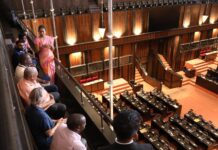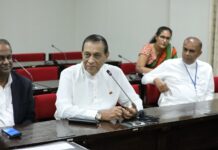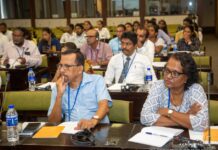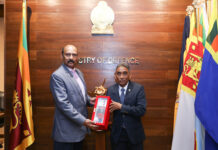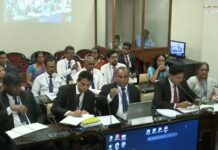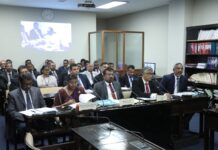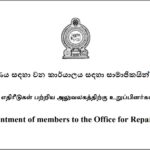Compiled by: Gp Capt Kumar Kirinde, SLAF (Retd)
Introduction
Muhammad Hosni El Sayed Mubarak (4 May 1928 – 25 February 2020) was an Egyptian military and political leader who served as the fourth president of Egypt from 1981 to 2011. Before he entered politics, Mubarak was a career officer in the Egyptian Air Force. He served as its commander from 1972 to 1975 and rose to the rank of air chief marshal in 1973. In 1975, he was appointed vice president by President Anwar Sadat and assumed the presidency after his assassination in 1981. Mubarak’s presidency lasted almost thirty years, making him Egypt’s longest-serving ruler since Muhammad Ali Pasha, who ruled the country for 43 years from 1805 to 1848. He assumed the presidency after a referendum, and renewed his term through referendums in 1987, 1993, and 1999. Under United States pressure, Mubarak held the country’s first multi-party election in 2005 and Mubarak renewed his term for the fourth time by winning it. Despite providing stability and reasons for economic growth, his rule was repressive. The state of emergency, which had not been lifted since the 1967 war, stifled political opposition, the security services became known for their brutality, and corruption spread. Mubarak stepped down during the Egyptian Revolution of 2011 after 18 days of demonstrations after transferring authority to
the Supreme Council of the Armed Forces. On 13 April 2011, a prosecutor ordered Mubarak and both of his sons (Alaa and Gamal) to be detained for 15 days of questioning about allegations of corruption and abuse of power. Mubarak was then ordered to stand trial on charges of negligence for failing to halt the killing of peaceful protesters during the revolution. On 2 June 2012, an Egyptian court sentenced Mubarak to life imprisonment. After sentencing, he was reported to have suffered a series of health crises.
Mubarak was detained in a military hospital while his sons were freed on 12 October 2015 by a Cairo court. He was acquitted by the Court of Cassation (the nation’s high court of appeal) of conspiring in the killing of protesters during the 2011 uprising and was released on 24 March 2017. Mubarak died on 25 February 2020, aged 91. He received a military burial at a family plot outside Cairo.
Family
Hosni Mubarak married Suzanne Saleh Thabet (b. 1941), Born to an Egyptian father and a British mother. She is a sociologist after graduating from American University in Cairo (AUC) with a bachelor’s degree in political science and then receiving a master’s degree in sociology. Together they had two sons: Alaa and Gamal. Through his son Alaa, Mubarak had two grandsons, Mohammed and Omar; and through his son Gamal, he had a granddaughter Farida.
Air Force career
Hosni Mubarak born on 4 May 1928 originally joined Military Academy but on 2 February 1949, he left and joined the Air Force Academy. He gained his commission as a pilot officer on 13 March 1950 and eventually receiving a bachelor’s degree in aviation sciences.
Mubarak served in various formations and units of the Egyptian Air Force; he spent two years in a Spitfire fighter squadron. Sometime in the 1950s, he returned to the Air Force Academy as an instructor, remaining there until early 1959. From February 1959 to June 1961, Mubarak undertook further training in the Soviet Union, attending a Soviet pilot training school in Moscow and another at Kant Air Base near Bishkek in the Kirghiz Soviet Socialist Republic. Mubarak undertook training on the Ilyushin Il-28 and Tupolev Tu-16 jet bombers.
In 1964 he gained a place at the Frunze Military Academy in Moscow. On his return to Egypt, he commanded a wing before becoming a base commander. He commanded the Cairo West Air Base in October 1966 then briefly commanded the Beni Suef Air Base. In November 1967, Mubarak became the Air Force Academy’s commander when he was credited with doubling the number of Air Force pilots and navigators during the pre-October War years.
Two years later, he became Chief of Staff for the Egyptian Air Force. In 1972, Mubarak became Commander of the Egyptian Air Force and Deputy Minister of Defense. On 6 October 1973, at the breakout of the Yom Kippur War, the Egyptian Air Force launched a
surprise attack on Israeli soldiers on the east bank of the Suez Canal. Egyptian pilots hit 90% of their targets, making Mubarak a national hero. The next year he was promoted to Air Chief Marshal in recognition of service during the October War of 1973 against Israel.
Becoming the Vice President of Egypt In April 1975, President Anwar Sadat appointed Mubarak Vice President of Egypt. In this position, he took part in government consultations that dealt with the future disengagement of forces agreement with Israel. In September 1975, Mubarak went on a mission to Riyadh and Damascus to persuade the Saudi Arabian and Syrian governments to accept the disengagement agreement signed with the Israeli government, but was refused a meeting by the Syrian President Hafez AlAssad. Sadat also sent Mubarak to numerous meetings with foreign leaders outside the Arab world. Sadat even transferred his decision-making authority to Mubarak temporarily at times he
went on vacations.
Becoming President of Egypt
President Sadat, the third was assassinated October 1981 by a group of soldiers while reviewing a military parade in Cairo. Mubarak who was seated next to Sadat also got injured. Mubarak being the vice president at that time became the new (fourth) president of Egypt after a referendum.

Egypt’s return to the Arab League
At that time Egypt was the only state in the history of the Arab League to have had its membership suspended, because of President Sadat’s peace treaty with Israel. In June 1982, Mubarak met King Fahd of Saudi Arabia, which marked a beginning of an Egyptian-Saudi rapprochement. Since Egypt is the most populous Arab country and Saudi Arabia the richest, the Saudi–Egyptian axis was a powerful force in the Arab world. At an Arab League summit later in 1982 in Fez, Saudi Arabia put forward an Egyptian peace plan where in exchange for Israel resolving the Israeli–Palestinian conflict by allowing a Palestinian state, the entire Arab world would make peace with Israel. In 1989, Egypt was re-admitted as a full member to the Arab League and the League’s headquarters were moved to their original location in Cairo.
Egypt in the forefront in neutralizing Ayatollah Khomeini’s intention to make Iran the leader of the Islamic world
The Islamic Republic of Iran had, from 1979 onward, been making the claim to be the leader of the Islamic world, and in particular Ayatollah Khomeini had called for the overthrow of the governments of Iraq, Saudi Arabia, Kuwait and other Arab states along the southern shores of the Persian Gulf, calling these states illegitimate. The claim of the Ayatollah Khomeini to be the rightful leader of the Islamic world and his attempts to export the Iranian revolution by working to overthrow governments that Khomeini deemed un-Islamic caused profound alarm and fear in the governments that were targeted like Iraq and Saudi Arabia. In the face of the Iranian challenge, the other Arab states looked towards Egypt as an ally. For King Fahd of Saudi Arabia and the other leaders of the Arab Gulf states, the Israeli–Palestinian conflict faded into the background and the main concern was resisting Iranian pretensions to be the leader of the Islamic world, meaning that Egypt could not be ignored.
Governing style
Throughout the 1980s, Mubarak increased the production of affordable housing, clothing,
furniture, and medicine. By the time he became President, Mubarak was one of a few Egyptian officials who refused to visit Israel and vowed to take a less enthusiastic approach to normalizing relations with the Israeli government. Egypt’s heavy dependence on US aid and its hopes for US pressure on Israel for a Palestinian settlement continued under Mubarak. He quietly improved relations with the former Soviet Union. In 1987, Mubarak won an election to a second six-year term. In his early years in power, Mubarak expanded the Egyptian State Security Investigations Service and the Central Security Forces (anti-riot and containment forces). It was believed that the experience of seeing his predecessor assassinated “right in front of him” and his lengthy military career—which was longer than those of Nasser or Sadat—may have instilled in him more focus and absorption with security than seemed the case with the latter heads of state. Mubarak sought advice and confidence not in leading ministers, senior advisers or leading intellectuals, but from his security chiefs—”interior ministers, army commanders, and the heads of the ultrainfluential intelligence services.”
Assassination threats
Because of his positions against Islamic fundamentalism and his diplomacy towards Israel,
Mubarak was the target of repeated assassination attempts. According to the BBC, Mubarak
survived six attempts on his life. In June 1995, there was an alleged assassination attempt
involving noxious gases and Egyptian Islamic Jihad while Mubarak was in Ethiopia for a
conference of the Organization of African Unity. He was also reportedly injured by a knifewielding assailant in Port Said in September 1999. Gulf War in 1991, invasion of Iraq in 2003: Egypt’s response and stance Egypt was a member of the allied coalition during the 1991 Gulf War; Egyptian infantry were some of the first to land in Saudi Arabia to remove Iraqi forces from Kuwait. Egypt’s participation in the war solidified its central role in the Arab World and brought financial benefits for the Egyptian government. Reports of sums of up to US$20 billion worth of debt forgiveness from America, the Arab states of the Persian Gulf, and Europe were published in the news media. President Mubarak spoke out against the 2003 invasion of Iraq, arguing that the Israeli– Palestinian conflict should have been resolved first. He also said the war would cause “100 Bin Ladens”. However, as President he did not support an immediate US withdrawal from Iraq because he believed it would probably lead to chaos.
Mubarak’s return to power via referendums and an election
President Mubarak was re-elected by majority votes in a referendum for successive terms on four occasions in 1987, 1993, and 1999. Each time, Mubarak secured his position by having himself nominated by Parliament then confirmed without opposition in a eferendum. Under United States pressure, Mubarak held the country’s first multi-party election in 2005 and Mubarak renewed his term for the fourth time by winning it.The September 2005 ballot was a multiple-candidate election. But the electoral institutions and security apparatus remained under the control of the President. On 28 July 2005, Mubarak announced his candidacy. The election was scheduled for 7 September 2005; according to civil organizations that observed the election it was marred by mass rigging activities. In a move widely seen as political persecution, Ayman Nour, a dissident and candidate for the El-Ghad Party (“Tomorrow party”) was convicted of forgery and sentenced to five years’ hard labor on 24 December 2005.
State corruption during Mubarak’s presidency
While in office, political corruption in the Mubarak administration’s Ministry of the Interior rose dramatically. Political figures and young activists were imprisoned without trial. Illegal,
undocumented, hidden detention facilities were established, and universities, mosques, and
newspaper staff were rejected because of their political views. In 2005 Freedom House, a non-governmental organization that conducts research into democracy, reported that the Egyptian government under Mubarak expanded bureaucratic regulations, registration requirements, and other controls that often feed corruption. Freedom House said, “corruption remained a significant problem under Mubarak, who promised to do
much, but in fact never did anything significant to tackle it effectively”.
Protests calling for the overthrow of Mubarak
Protests against Mubarak and his regime erupted in Cairo and other Egyptian cities in January 2011 which went on for a month. On 1 February 2011, Mubarak announced he would not contest the presidential election due in September but would like to finish his current term and promised constitutional reform. This did not satisfy most protesters, who expected Mubarak to depart immediately. Mubarak stated in a speech that he would not leave, and would die on Egyptian soil. Opposition leader Mohamed ElBaradei paid no attention to Mubarak’s remarks and labeled it as a trick designed to help Mubarak to stay in power. The demonstrations continued and on 2 February, violent clashes occurred between pro-Mubarak and anti-Mubarak protesters occurred in front of the Presidential Palace.
Mubarak’s resignation as President of Egypt
On 10 February 2011, contrary to rumours, Mubarak said he would not resign until the
September election, though he would be delegating responsibilities to Vice President Omar
Suleiman. However on 11 February, then Vice President Omar Suleiman announced Mubarak had resigned and that power would be turned over to the Egyptian Military Council. The announcement sparked cheers, flag-waving, and celebrations from protesters in Egypt. Two and a half hours after Mubarak’s resignation, an Egyptian military member came on air and thanked Mubarak for “putting the interests of the country first.” The statement, which said “The Supreme Council is currently studying the situation,” did not state what the council would do next.
Allegations against Mubarak of personal corruption
In February 2011, ABC News reported that experts believed the personal wealth of Mubarak and his family was between US$40 billion and US$70 billion from military contracts made during his time as an air force officer. The Guardian reported that Mubarak and his family might be worth up to US$70 billion garnered from corruption, bribes and legitimate business activities. The money was said to be spread out in various bank accounts, including some in Switzerland and the UK, and invested in foreign property. The newspaper said some of the information about the family’s wealth might be ten years old. According to Newsweek, these allegations are poorly substantiated and lack credibility.
On 12 February 2011, the government of Switzerland announced it was freezing the Swiss bank accounts of Mubarak and his family. On 20 February 2011, the Egyptian Prosecutor General ordered the freezing of Mubarak’s assets and those of his wife, his sons Alaa and Gamal Mubarak, and his daughters-in-law. The Prosecutor General also ordered the Egyptian Foreign Minister to communicate this to other countries where Mubarak and his family could have assets. This order came two days after Egyptian newspapers reported that Mubarak filed his financial statement. Egyptian regulations mandate government officials submit a financial statement listing their assets and sources of income while performing government work. On 21 February 2011, the Egyptian Military Council, which was temporarily given the presidential authorities after the resignation of Mubarak, said it had no objection to a trial of Mubarak on charges of corruption.
Mubarak’s life post-resignation
Mubarak made no media appearances after his resignation. Except for his family and a close circle of aides, he reportedly refused to talk to anyone—even his supporters. His health was speculated to be rapidly deteriorating; some reports said he was in a coma. Most sources said he was no longer interested in performing any duties and wanted to “die in Sharm El-Sheikh”. On 23 February 2011, the Egyptian newspaper Eldostor reported that a “knowledgeable source” described the order of the Prosecutor General to freeze Mubarak’s assets and the threats of a legal action as nothing but a signal for Mubarak to leave Egypt after a number of attempts were made to encourage him to leave willingly. In February 2011, Voice of America reported that Egypt’s top prosecutor had ordered a travel ban and an asset freeze for Mubarak and his family as he considered further action.
On 28 February 2011, the General Prosecutor of Egypt issued an order prohibiting Mubarak and his family from leaving Egypt. It was reported that Mubarak was in contact with his lawyer in case of possible criminal charges against him. As a result, Mubarak and his family were placed under house arrest at a presidential palace in the Red Sea resort of Sharm el-Sheikh. On 13 April 2011, a prosecutor originally appointed by Mubarak ordered the former president and both his sons to be detained for 15 days of questioning about allegations of corruption and abuse of power amid growing suspicion that the Egyptian military was more aligned with the Mubaraks than with the revolution. Gamal and Alaa were jailed in Tora Prison; state television reported that Mubarak was in police custody in a hospital near his residence following a heart attack. Former Israeli Cabinet minister Benjamin Ben Eliezer told Israeli Radio that he had offered Mubarak refuge in the southern Israeli city of Eilat.
On 11 May 2013, Mubarak in his first media appearance since his resignation said, “History will judge and I am still certain that the coming generations will view me fairly.”
Mubarak’s trial and conviction.On 24 May 2011, Mubarak was ordered to stand trial on charges of premeditated murder of peaceful protesters during the revolution and, if convicted, could face the death penalty. The decision to try Mubarak was made days before a scheduled protest in Tahrir Square. The full list of charges released by the public prosecutor was “intentional murder, attempted killing of some demonstrators … misuse of influence, deliberately wasting public funds and unlawfully making private financial gains and profits”.
On 28 May, a Cairo administrative court found Mubarak guilty of damaging the national economy during the protests by shutting down the Internet and telephone services. He was fined LE200 million—about US$33.6 million—which the court ordered he must pay from his personal assets. This was the first court ruling against Mubarak, who would next have to answer to the murder charges. The trial of Hosni Mubarak, his sons Ala’a and Gamal, former interior minister Habib el-Adly and six former top police officials began on 3 August 2011 at a temporary criminal court at the Police Academy in north Cairo. They were charged with corruption and the premeditated killing of peaceful protesters during the mass movement to oust the Mubarak government, the latter of
which carries the death penalty. The trial was broadcast on Egyptian television; Mubarak made an unexpected appearance—his first since his resignation. He was taken into the court on a hospital bed and held in a cage for the session.
Upon hearing the charges against him, Mubarak pleaded not guilty. Judge Ahmed Refaat
adjourned the court, ruling that Mubarak be transferred under continued arrest to the military hospital on the outskirts of Cairo. On 15 August, the second session was held and it lasted three hours. At the end of the session, Rifaat announced that the third session would take place on September and that the remainder of the proceedings would be off-limits to television cameras. The trial resumed in December 2011 and lasted until January 2012. The defense strategy was that Mubarak never actually resigned, was still president, and thus had immunity. On 2 June 2012, Mubarak was found guilty of not halting the killing of protesters by the Egyptian security forces; he was sentenced to life imprisonment.
The court found Mubarak not guilty of ordering the crackdown on Egyptian protesters. All other charges against Mubarak, including profiteering and economic fraud, were dismissed. Mubarak’s sons, Habib el-Adly, and six senior police officials were all acquitted for their roles in the killing of demonstrators because of a lack of evidence. According to The Guardian, the relatives of those killed by Mubarak’s forces were angered by the verdict. Thousands of demonstrators protested the verdict in Tahrir Square, Arbein Square and Al-Qaed Ibrahim Square.
In January 2013, an appeals court overturned Mubarak’s life sentence and ordered a retrial. He remained in custody and returned to court on 11 May 2013 for a retrial on charges of complicity in the murder of protesters. On 21 August 2013, a Cairo court ordered his release. Judicial sources confirmed that the court had upheld a petition from Mubarak’s longtime lawyer that called for his release. A day later, interim Prime Minister Hazem El Beblawi ordered that Mubarak be put under house arrest. On 21 May 2014, while awaiting retrial, a Cairo court convicted Mubarak and his sons of embezzling the equivalent of US$17.6 million of state funds which were allocated for renovation and maintenance of presidential palaces but were instead diverted to upgrade private family homes. The court ordered the repayment of US$17.6 million, fined the trio US$2.9 million, and
sentenced Mubarak to three years in prison and each of his sons to four years. In November 2014, conspiracy to kill charges were dismissed by the Cairo Criminal Court on a
technicality.
The court also cleared Mubarak of corruption charges. On 13 January 2015, Egypt’s Court of Cassation overturned Mubarak’s and his sons’ embezzlement charges, the last remaining conviction against him, and ordered a retrial. A retrial on the corruption charges led to a conviction and sentencing to three years in prison in May 2015 for Mubarak, with four-year terms for his sons, Gamal and Alaa. It was not immediately
clear whether the sentence would take into account time already served – Mubarak and his sons have already spent more than three years in prison, so potentially will not have to serve any additional time. Supporters of Mubarak jeered the decision when it was announced in a Cairo courtroom on 9 May. The sentence also included a 125 million Egyptian pound (US$16.3 million) fine.
Health problems from 2010 to 2014
In July 2010, the media said Egypt was about to undergo dramatic change because Mubarak was thought to have cancer and because of the scheduled 2011 presidential election. Intelligence sources said he had esophageal cancer, stomach or pancreatic cancer; this was denied by Egyptian authorities. Speculation about his ill health increased after his resignation from the presidency in February 2011. According to Egyptian media, Mubarak’s condition worsened after he went into exile in Sharm el-Sheikh. He was reportedly depressed, refused to take medications, and was slipping in and out of consciousness. According to the source—an unnamed Egyptian security official— “Mubarak wants to be left alone and die in his homeland”. The source denied that Mubarak was writing his memoirs, stating that he was almost completely unconscious. After his resignation, Egypt’s ambassador to the United States Sameh Shoukry reported that his personal sources said Mubarak “is possibly in somewhat of bad health”, while several Egyptian and Saudi Arabian newspapers reported that Mubarak was in a coma and close to death. On 12 April 2011, it was reported that he had been hospitalized after suffering a heart attack during
questioning over possible corruption charges.
In June 2011, Mubarak’s lawyer said his client “has stomach cancer, and the cancer is growing”. Mubarak had undergone surgery for the condition in Germany in 2010 and also suffered from circulatory problems with an irregular heartbeat. On 13 July 2011, unconfirmed reports stated that Mubarak had slipped into a coma at his residence after giving his final speech, and on 17 July, his lawyer confirmed the reports. On 26 July 2011, Mubarak was reported to be depressed and refusing solid food while in hospital being treated for a heart condition and in custody awaiting trial. On 2 June 2012, Mubarak was reported as have suffered a health crisis while being transported to prison after his conviction on the charges of complicity in the killing of protestors. Some sources reported he had had a heart attack. Further reports stated that Mubarak’s health continued to decline; some said he had to be treated with a defibrillator. On 20 June 2012, as
Mubarak’s condition continued to decline, state-run media erroneously reported that the former president had been declared “clinically dead”, causing widespread confusion. Officials later clarified that Mubarak was in a critical condition.
On 27 December 2012, Mubarak was taken from Tora Prison to the Cairo military hospital after falling and breaking a rib. He was released from prison in August 2013.
On 19 June 2014, Mubarak slipped in the bathroom at the military hospital in Cairo where he was being held and broke his left leg, also fracturing his left thighbone, requiring surgery. Mubarak was serving a three-year sentence for corruption, and also awaiting retrial regarding the killing of protesters during his regime. At one time, his release was ordered. However, Mubarak had remained at the military hospital since January 2014 due to his ongoing health issues. Acquittal and death On 2 March 2017, the Court of Cassation, Egypt’s top appeals court, acquitted Mubarak of conspiring in the killing of protesters during the 2011 uprising. He was subsequently released on 24 March 2017. Mubarak died on 25 February 2020, aged 91. He received a military burial at a family plot outside
Cairo.
Source: https://en.wikipedia.org/wiki/Hosni_Mubarak




